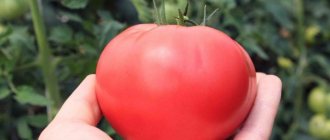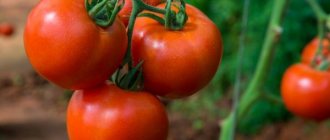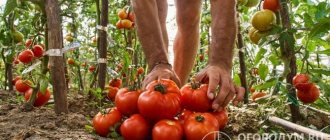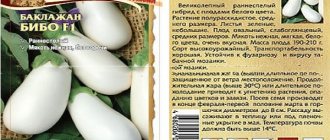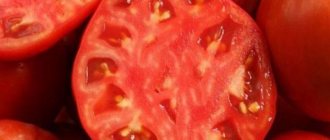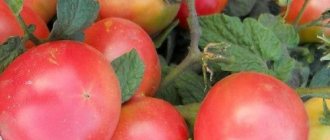How to grow properly
Seed sowing for seedlings is recommended, carried out in the first weeks of spring:
- Seeds are planted in fertile soil. The substrate can be purchased ready-made at the store or made yourself by mixing garden soil and humus.
- Containers with sown seeds should be covered with plastic wrap and stored in a warm place. Remove the film daily for ventilation, moisten the soil as it dries.
- When the shoots appear, remove the film and place the pots with planting material in a well-lit place.
- Harden off the seedlings a week before transplanting to an open bed or greenhouse. The soil temperature for planting must be at least 20°C.
Growing and care
Young shoots can die even with a slight drop in air temperature, so in the northern part of the country it is preferable to plant planting material in a greenhouse. An area of 1 m2 can accommodate 5 bush plantings.
Note! The yield will be higher if zucchini or cauliflower grew in front of the tomatoes. This is due to the large amount of useful substances in the soil that remain after they are grown.
This is due to the large amount of useful substances in the soil that remain after they are grown.
To irrigate Thick Cheeks tomatoes, warm, settled water is used. The soil must be constantly loosened. Fertilize the crop twice per season with complex mineral compounds. As it grows, you need to do pinching so that the bush is formed correctly and does not branch.
Tomato Thick Cheeks is a new, but productive variety of tomatoes that has won the trust of gardeners.
Growing tomatoes is not a difficult task, especially when it comes to varieties that are resistant to unfavorable conditions. Tomato Thick cheeks is a relatively new productive variety of tomatoes, which has become a real godsend for gardeners.
Description of the variety
The tomato variety Thick Cheeks is declared as a medium-sized shrub, but in practice, under favorable conditions, it grows up to 2 m. Its fruits are red, large and fleshy. The shape is rounded-flattened and slightly ribbed. The weight of one tomato can reach 0.2-0.6 kg, and the yield from one bush can reach up to 6 kg. The taste is distinctly tomato, rich, sweetish, with a slight sourness.
The fruits of Thick Cheeks are perfect for pickling, canning and fresh cooking.
Being mid-season, the Thick Cheeks variety begins to bear fruit 3.5-4 months after emergence. The varietal feature is a long “swaying” in the first weeks, then the bush quickly gains strength and creates a good load - 5-8 tiers of fruit clusters.
Origin of the variety
Thick cheeks were bred by Russian breeders on the basis of two independent laboratories: Agro and. The common name hides two similar products, but with some varietal differences.
Both manufacturers guarantee mid-ripening, unpretentiousness, specific appearance and taste of the fruit. However, “Gavrish” tomatoes, unlike their competitor, have a short bush and smaller fruits. The features of agricultural technology and care conditions for them are mostly the same.
Landing region
Since Thick Cheeks is a mid-season variety, ideal conditions for its growth will be in warm southern regions, where the fruits will fully gain ripeness and sweetness. However, gardeners successfully cultivate Shchechki in central Russia, in the central and southern Urals, and in western Siberia.
In the northern regions there is not enough heat and light, so preference is given to early-ripening tomato varieties with a shorter growing season. In addition to Russia, Thick Cheeks are cultivated in Ukraine, Moldova, and Belarus.
Ripening time and yield
The entire period, from planting seeds to fruiting, is 110-120 days. The first tomatoes ripen by the end of July, but their harvest continues until the end of September. Then the last fruits are removed from the bush and left to ripen at 16-18°C.
On average, one bush growing in an open garden bed produces a harvest of 4-5 kg. In greenhouses, where conditions are ideal, you can harvest up to 6-7 kg. The largest fruits are formed at the beginning of fruiting.
Growing seedlings
Thick Cheeks are planted with seeds for seedlings in early March (seeds from Gavrish - in the second half of March). In the south of the country, sowing can begin by the end of February. Thus, the period between sowing and planting seedlings in the ground or greenhouse should be 55-60 days.
Growing seedlings requires good lighting, high humidity and a temperature of 16-25°C. The ideal place for this in the house would be the window sill. It is best if the seedlings are located on southern windows.
Characteristics of tomato
Tomato Thick cheeks determinate. It can be grown both in greenhouses and in open ground. The fruits ripen in 103-110 days from the moment of sowing the seeds to harvesting. The characteristics of this variety are surprising. Despite its short stature, the tomato is a high-yielding variety. In addition, it has immunity to diseases and pests.
Description of the tomato bush
Thick cheek tomatoes are easy to grow not only in a greenhouse, but also outside. In addition, the compactness of the bushes (up to 70 cm in height) is combined with the power of the stems, which can support a weight of fruit up to 5 kg. You still can’t do without tying. All necessary supports are installed immediately after planting the seedlings in the ground.
The foliage of this bush is medium-sized, dense, dark green.
For the fruit to fully ripen, it is important to obtain a sunny color, so dense foliage is often pruned, as are the stepsons. Such measures help normalize the distribution of energy by the root system
This way the bush will concentrate its energy on ripening the fruits.
Description of fruits
From one Thick Cheeks tomato bush, when grown in open ground, you can get up to 4 kg of tomatoes.
In a greenhouse, the yield is higher. Domestic gardeners are confident that with proper care it is possible to achieve higher results.
The quality of the tomatoes themselves is no less important. Like most tomatoes, they are red in color. Their weight is small - up to 220 g, and their shape is flat-round. According to the characteristics, the fruits are characterized by the following:
- juicy pulp with a small amount of seeds;
- no tendency to crack the skin;
- good presentation of the fruit;
- good transport tolerance and long-term storage.
Advantages
According to reviews, the “rosy cheeks” tomato variety has a number of advantages. These include:
- no cracking;
- rich taste;
- the opportunity to collect your own seeds for planting;
- large fruit;
- resistance to diseases (manages to produce a good harvest before late blight appears);
- versatility in use;
- good transportability and keeping quality;
- excellent yield.
According to vegetable growers, there are simply no disadvantages to this variety. In their opinion, the “rosy cheeks” tomato should be allocated a place on the site for cultivation in a greenhouse. Strict adherence to the rules of traditional agricultural technology, care and maintenance - all this will allow you to obtain high yields of tomatoes.
Description and characteristics of the variety
The Thick Cheeks tomato can surprise you with its excellent taste and remarkable sales performance. It is a determinate, low-growing variety with strong shoots.
- stem height 60-70 cm;
- number of fruitful branches 7-8;
- leaves are dark green, dense;
- pronounced foliage;
- 5-6 tomatoes are tied in clusters.
What are the characteristics of ripe tomatoes, description of the fruit:
- average weight 200-220 g;
- versatility of use;
- non-cracking skin;
- soft, tender, moderately juicy pulp;
- possibility of long-term storage;
- seed chambers 4-5;
- sugar level 5%.
Origin of the variety
2 agricultural companies took part in the creation of the tomato. The breeding was carried out by the Gavrish and Aelita concerns. There are varietal similarities and differences. What common:
- average ripening times;
- appearance and taste criteria of ripened fruits;
- simple agricultural techniques.
Landing region
The variety is safely grown in unprotected beds in the Crimea and Krasnodar Territory. In the temperate zone and the Moscow region, plantings are carried out in greenhouses. In Siberia and the Urals, heating of shelters may be required.
Advantages of a hybrid
The characteristics and description of the variety indicate the high productivity of the crop. As a first-generation hybrid, tomatoes cannot reproduce high-quality offspring for the next season. Therefore, it is recommended to purchase seeds in specialized stores.
A low-growing bush with a height of 100 cm has limited growth. During the growing season, 6-8 clusters with peduncles located on a strong stem are formed. The branched root system expands almost 1 m deep.
Tomatoes are resistant to late blight and tobacco mosaic virus. The plant is not affected by biological pests (mole cricket). The culture adapts well to temperature changes.
The universal growing method allows you to cultivate tomatoes in open ground and greenhouses. The tomato yield is 9 kg per 1 m².
Description of fruits:
- Tomatoes have excellent taste.
- The pulp of the fruit is juicy, tender, and sweet and sour in taste.
- Medium-sized tomatoes, weighing up to 100 g.
- Red cheek tomatoes have a round, flattened shape, a ribbed surface, and a thin glossy skin.
- Unripe fruits are pale green.
- At technical ripeness, tomatoes acquire a rich red color.
- When cut horizontally, 3-4 seed chambers with numerous seeds are observed.
- The dry matter content is below average.
In cooking, tomatoes are used for preparing salads, pickling, and marinades. They are used to produce tomato paste and juices.
Bush care
Next, tomato bushes need the following care:
Watering is carried out in the evening hours, after sunset, trying to get water under the root. Water abundantly, twice a week. For irrigation, use only warm, settled water. 10 days after transplantation, tomato bushes are not watered. However, in the future the following standards are adhered to: during flowering - up to 35 liters per 1 m2, during fruit set - up to 50 liters per 1 m2, during the period of fruit growth and before they begin to ripen - up to 80 liters per 1 m2;
- Feed two to three times during the season using complex and organic fertilizers;
- Periodically, after watering, loosen the soil;
- Better yields can be achieved if the bush is formed into two stems;
- It is also necessary to tie the bushes to a support or trellis;
- Experienced vegetable growers advise removing some of the leaves to improve the illumination of the bushes.
Reviews from gardeners
- Vladimir S., 58 years old: For the first time I planted the Thick Cheeks category in my garden, and did not regret it. The tomatoes are not large and even, the copra is juicy, and the taste is simply excellent. The care required was the same as for other varieties. Tomatoes are good to eat fresh; they make excellent preparations. Smaller fruits can be pickled with all their giblets. The color of the fruit is red, the skin is strong. Tomatoes can be kept raw for a long time without losing their flavor.
- Zinaida S., 55 years old: My neighbor in the country advised me to plant this variety of tomato. The last time I planted Thick Cheeks was last year and I was pleased. Pomona gifts are all smooth and dense. Great for marinating. Almost all of my family ate the fruits fresh, but some were used for processing. The taste of the fruit is sweetish, the flesh is tender. Now I will grow this variety every year.
- Olga, 48 years old: I really liked the Fat Cheeks variety. The bushes are not tall, they were grown in a greenhouse. (as stated in the instructions, I tore off the lower leaves and stepsons, tied them to wooden supports. The fruits all turned out smooth and bright red. Excellent for harvesting. Don’t forget about fertilizers. Over the summer, I fed the bushes with organic matter and minerals 3 times. Isn’t that all If you follow the rules, you can reap an excellent harvest. I was pleased with the result.
READ MORE: Herbicide racer instructions for use mechanism of action and consumption rates
Planting and care
How to sow correctly:
- Prepare fertile loose soil.
- Moderately moisturize.
- Make grooves 2 cm deep at a distance of 4 cm.
- Spread the seeds every 3 cm.
- Irrigate with water.
- Compact and cover with film until germination.
Before the sprouts appear, the containers are placed in a warm place and ventilated once a day for 10-15 minutes. Make sure the soil is moderately moist.
How to care for seedlings so that they are strong and strong:
- Irrigation with settled water, use of calcium liquid.
- Feeding 2-3 times during the entire growing period.
- Diving when there are 2-3 true leaves.
- Lighting with special phytolamps.
Growing tomatoes
It is advisable to grow the “Fat Cheeks” variety through seedlings.
How to prepare seeds:
- The purchased seed material does not need to be prepared for sowing, since it was processed in production laboratories;
- However, personally collected material must be disinfected to destroy possible pathogens. To soak the seeds, use: 1% manganese solution (15 minutes), 0.5% soda solution (for 24 hours) and the drug “Fitosporin” (15-20 minutes).
Sowing seed material:
- Sowing of seed material for seedlings begins in late March;
- It is advisable to use ready-made soil for seedlings. However, garden soil needs to be disinfected. For this purpose, calcination in the oven, pouring boiling water or treatment with a concentrated manganese solution is used. Soil preparation begins 10 days before sowing. During this period, soil bacteria will multiply in it;
- Any shallow container is used as a container - boxes, peat cups, yogurt jars. The selected container is filled with prepared moist soil, the seed material is laid out on it and sprinkled with the same soil on top. The interval between seeds is maintained at 1-2 cm;
- Next, the containers are covered with film to create a greenhouse effect and left in a warm place with a temperature range of up to +30 degrees;
- The humidity level in the container should be between 80-90%. As the soil dries, moisten it with a spray bottle. If the humidity is high, the film is slightly opened to allow the contents of the container to dry. If fungus appears, the affected soil is removed and the remaining soil is treated with Fitosporin solution;
- When growing seedlings in one container, in the phase of two true leaves, the seedlings dive. Tomato seedlings are watered 2-3 days before picking to minimize trauma to the root system during transplantation. During the procedure, the seedlings are fed with mineral fertilizers;
- Subsequent plantings require 16 hours of lighting. To do this, containers are placed on southern window sills. The soil humidity level should be in the range from 40 to 50%, and the temperature range from +16 to +25 degrees.
Rules for planting seedlings:
- Transplantation to a permanent place begins in the second half of May, when it is warmed up to +18 degrees;
- Since the variety is quite heat-loving, it is better to grow it in well-warmed and illuminated areas. It is optimal if onions, cabbage or zucchini previously grew on it. It is not recommended to plant after potatoes, eggplant, physalis and pepper. In hilly areas, planting is carried out on southern slopes;
- Immediately before transplanting, add a handful of wood ash, onion peel, chopped banana peel or yeast mixture to the planting holes. All these are natural sources of potassium, which ensures normal growth of tomato crops;
- In the prepared area, the beds are placed in the direction of the sun. The row spacing is set to 60 cm, the interval between planting holes should be at least 50 cm. When planting, the recommended density must be observed, i.e. no more than 6-8 seedlings are placed per 1 m2.
Soil preparation
Thick Cheeks is a heat-loving plant, which means the area for it should be well heated and lit. Ideally, onions, cabbage or zucchini grew on it last season. Potatoes, eggplants, physalis and peppers will be bad predecessors. Wind protection is an important factor. In hilly areas, tomatoes are planted on southern slopes.
During the growth process, tomatoes actively consume potassium, nitrogen and phosphorus. Therefore, during autumn digging, you need to add these fertilizers to the soil, but in small quantities and in combination with organic matter - manure or compost. Fertilizers are scattered over the area and then dug up to a depth of a shovel. With the arrival of spring, the area is loosened a little, weeds are removed and the soil is leveled with a rake.

